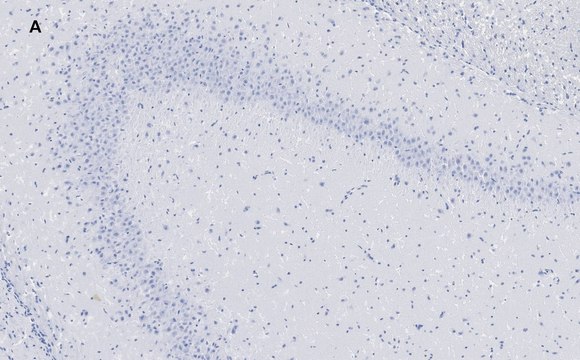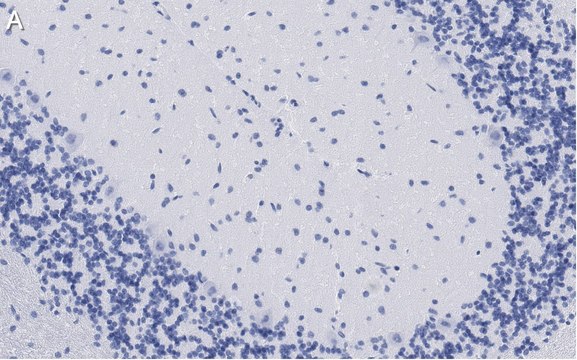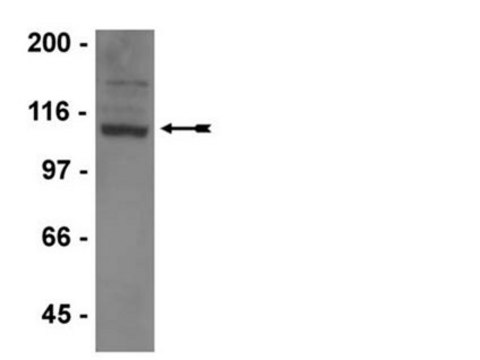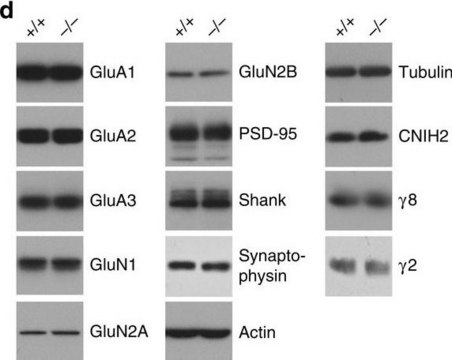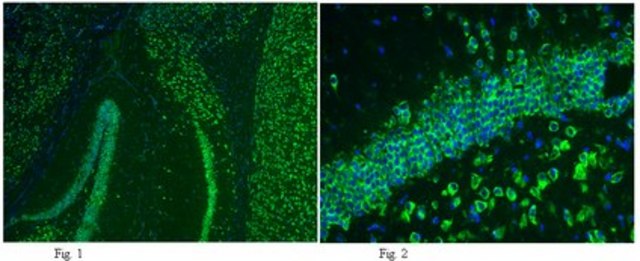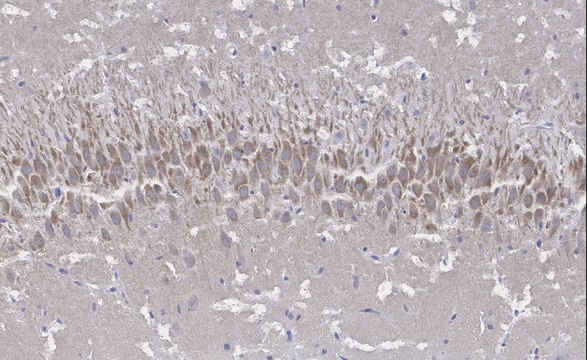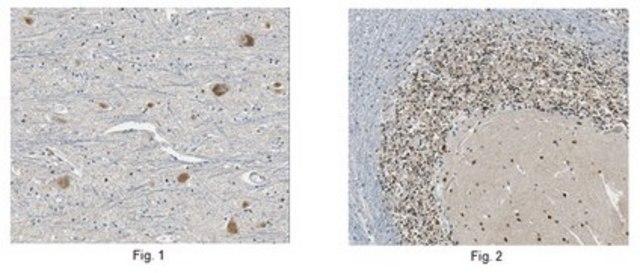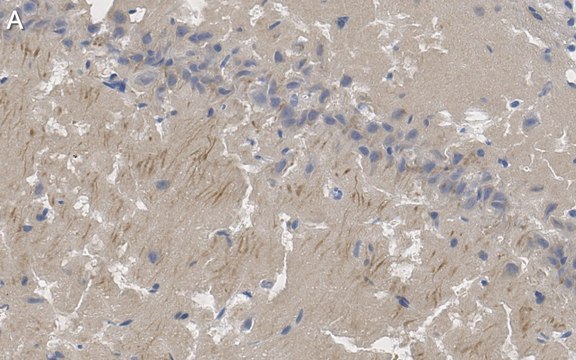推荐产品
生物来源
mouse
质量水平
抗体形式
purified antibody
抗体产品类型
primary antibodies
克隆
14C12.2, monoclonal
种属反应性
mouse, rat, human
技术
immunohistochemistry: suitable (paraffin)
western blot: suitable
同位素/亚型
IgG2aκ
NCBI登记号
UniProt登记号
运输
ambient
靶向翻译后修饰
unmodified
基因信息
human ... GRIA2(2891)
一般描述
谷氨酸受体2(UniProt P19491;也称为AMPA选择性谷氨酸受体2、GluA2、GluR-2、GluR-B、GluR-K2、GluR2、谷氨酸受体离子型、AMPA 2)由大鼠物种中的Gria2(也称为GluR2)基因(基因ID 29627)编码。谷氨酸受体是主要位于神经元细胞膜上的突触受体。这些受体通过介导谷氨酸依赖性突触后兴奋在神经交流、记忆形成、学习和调节中起重要作用。谷氨酸受体分为两类,离子型谷氨酸受体(iGluRs)和代谢型谷氨酸受体(mGluRs)。iGluR在谷氨酸结合后形成离子通道孔,而mGluR通过G蛋白偶联的信号级联反应间接激活质膜上的离子通道。尽管所有iGluR和mGluR都结合谷氨酸,但它们确实对化学配体(例如NMDA、红藻氨酸、AMPA、L-AP4、ACPD、L-QA)表现出不同的结合活性,并且这种独特的功能可用于将这些受体进一步分为亚型。谷氨酸受体2是AMPA型iGluR,GluR-1产生时具有一个N末端信号肽序列(a.a.1-24),其去除产生具有4个跨膜螺旋的成熟受体(a.a.544-564、592-610、617-637、813-833),具有一个大的N末端胞外域(a.a.24-543),然后是两个细胞内环(a.a.565-591、611-616),一个细胞外环(a.a.638-812)和一个C末端细胞质尾巴(a.a.834-883)。
特异性
克隆14C12.2靶向UniProt(P42262、P23819、P19491)报道的人、小鼠和大鼠GluR2的所有剪接亚型中存在的N末端胞外域内的表位。
免疫原
带有GST标记的重组大鼠GluR2 N末端胞外域片段。
应用
免疫组织化学分析:一个代表性批次以1:50-1,000稀释度在小鼠(海马体)和人(小脑和大脑皮层)脑组织切片中检测到GluR2。
蛋白质印迹分析:0.5 µg/mL的该抗体在10 µg大鼠脑膜提取物中检测到GluR2。
蛋白质印迹分析:0.5 µg/mL的该抗体在10 µg大鼠脑膜提取物中检测到GluR2。
抗GluR2,克隆14C12.2,目录号MABN1189是一种高度特异性的小鼠单克隆抗体,靶向谷氨酸受体2,并已在蛋白质印迹和免疫组织化学(石蜡)中进行了检验。
研究类别
神经科学
神经科学
质量
通过蛋白质印迹法在小鼠脑膜提取物中进行评价。
蛋白质印迹分析:0.5 µg/mL的该抗体在10 µg小鼠脑膜提取物中检测到GluR2。
蛋白质印迹分析:0.5 µg/mL的该抗体在10 µg小鼠脑膜提取物中检测到GluR2。
目标描述
观测分子量〜110 kDa。由于糖基化,目标条带大小大于计算分子量(去除信号肽)96.18/96.24/97.96/93.78 kDa(人亚型Flop/Flip/3/4)、96.02/83.54/101.9/100.2 kDa(小鼠亚型1/2/3/4)、90.05/96.11/97.78 kDa(大鼠亚型Flop/Flip/3)。在某些裂解物中可以观察到未鉴定的条带。
联系
替代:MAB397
外形
形式:纯化
纯化的小鼠IgG2a,溶于含0.1 M Tris-甘氨酸(pH 7.4)、150 mM NaCl和0.05%叠氮化钠的缓冲液中。
纯化蛋白G。
储存及稳定性
自接收之日起,在2-8°C下可稳定保存1年。
其他说明
浓度:请参考特定批次的数据表。
免责声明
除非我们的目录或产品随附的其他公司文件中另有说明,否则我们的产品预期仅用于研究用途,不得用于任何其他目的,包括但不限于未经授权的商业用途、体外诊断用途、离体或体内治疗用途或对人类或动物的任何类型的消费或应用。
未找到合适的产品?
试试我们的产品选型工具.
储存分类代码
12 - Non Combustible Liquids
WGK
WGK 1
闪点(°F)
Not applicable
闪点(°C)
Not applicable
Bridget A Matikainen-Ankney et al.
The Journal of neuroscience : the official journal of the Society for Neuroscience, 38(45), 9700-9711 (2018-09-27)
The G2019S mutation in leucine-rich repeat kinase 2 (LRRK2) is a prevalent cause of late-onset Parkinson's disease, producing psychiatric and motor symptoms, including depression, that are indistinguishable from sporadic cases. Here we tested how this mutation impacts depression-related behaviors and
Increased Fear Generalization and Amygdala AMPA Receptor Proteins in Chronic Traumatic Brain Injury.
Ann N Hoffman et al.
Journal of neurotrauma, 39(21-22), 1561-1574 (2022-06-21)
Cognitive impairments and emotional lability are common long-term consequences of traumatic brain injury (TBI). How TBI affects interactions between sensory, cognitive, and emotional systems may reveal mechanisms that underlie chronic mental health comorbidities. Previously, we reported changes in auditory-emotional network
John Lee et al.
eLife, 10 (2021-11-05)
Acoustic overexposure and aging can damage auditory synapses in the inner ear by a process known as synaptopathy. These insults may also damage hair bundles and the sensory transduction apparatus in auditory hair cells. However, a connection between sensory transduction
Stephanie A Mauriac et al.
Cells, 11(24) (2022-12-24)
Peroxisome Biogenesis Disorders (PBD) and Zellweger syndrome spectrum disorders (ZSD) are rare genetic multisystem disorders that include hearing impairment and are associated with defects in peroxisome assembly, function, or both. Mutations in 13 peroxin (PEX) genes have been found to
Lei-Lei Liu et al.
Molecular vision, 25, 780-790 (2019-12-11)
The neuromodulator dopamine plays an important role in light adaptation for the visual system. Light can stimulate dopamine release from dopaminergic amacrine cells (DACs) by activating three classes of photosensitive retinal cells: rods, cones, and melanopsin-expressing intrinsically photosensitive retinal ganglion
我们的科学家团队拥有各种研究领域经验,包括生命科学、材料科学、化学合成、色谱、分析及许多其他领域.
联系技术服务部门
